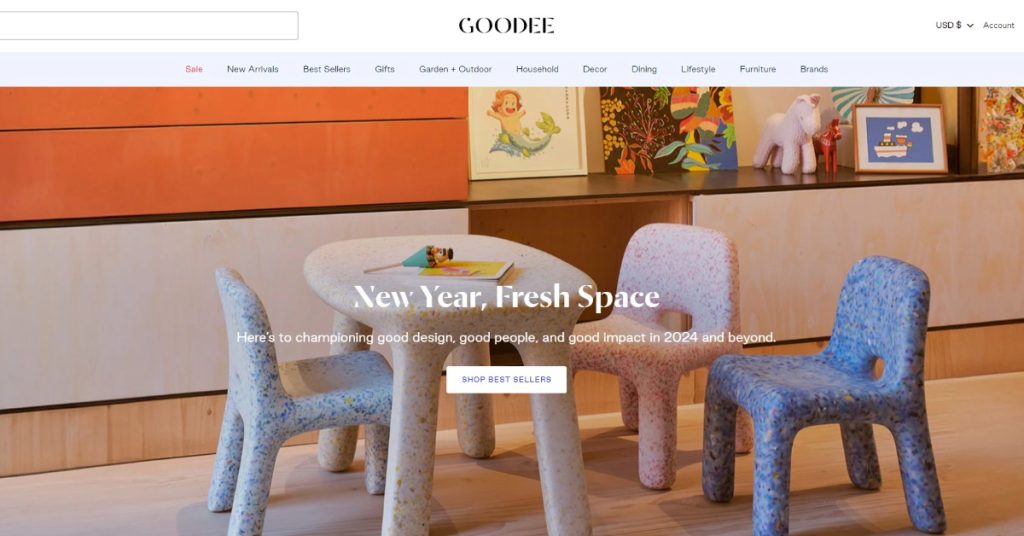
Goodee marketplace case study: book a demo to start yours
Goodee is an e-commerce platform dedicated to promoting sustainability and ethics, offering a thoughtfully curated collection of eco-friendly home goods, accessories, and lifestyle products sourced from brands and craftsmen who prioritize positive social and environmental contributions.
If you’d like to start your own marketplace like Goodee, you’re facing a buy vs build decision. So before you decide to build it in-house on top of Spree open-source, consider using the feature-rich Enterprise Edition cutting your time-to-market to a few weeks.
Build vs Buy a marketplace?
Open-source has its share of advantages, like total ownership and the freedom to customize. Yet, these perks often involve considerable costs. Developing a complete marketplace solution is a time-consuming and expensive task, usually taking months or years, as we have learned from multiple marketplace projects.
If speed and reliability are your priorities, choosing a pre-built, enterprise-ready solution like Spree Commerce Enterprise Edition is the practical path forward—backed by the experience of those who know how unpredictable and risky custom marketplace development can be.
Back to the Goodee marketplace case study
Twin brothers Byron and Dexter Peart founded Goodee, an online store, in 2017. Goodee is renowned for selling ethical and sustainable products, particularly for the home and lifestyle. The company focuses on responsibly sourcing and producing items that combine good design, good purpose, and good people.
Goodee’s core belief centers on promoting conscious consumerism. They actively serve a growing audience that values sustainability and ethics in their shopping habits.
Goodee carefully selects its product range, including home decorations and personal care products, for their design, sustainability, and impact. The company also features upcycled items and products that support gender advocacy, demonstrating various sustainability ideas actively.
One notable aspect of Goodee’s business is its achievement of B Corp Certification in February 2020. This certification actively highlights their dedication to social and environmental responsibility, transparency, and accountability. It actively aligns with their mission of promoting transparent sourcing, upcycling, fair treatment of employees, and waste reduction, all actively reflected in their high B Impact Assessment Score of 80.1.
In terms of statistics, Goodee impressively employs 97% sustainable and ethically sourced materials in their products. They actively ship 94% of orders with eco-friendly packaging. The company actively collaborates with 53 brands from 22 countries, with 55% of them being owned by women. Additionally, 30% of their products actively aim to preserve endangered crafts, and many of their brand partners operate in underserved areas.
How to emulate Goodee marketplace success?
To somewhat mirror Goodee’s achievements, it’s a good idea to launch your marketplace quickly, within weeks rather than months. Assess how well your products suit your audience’s demands and adjust your strategies for attracting customers based on actual feedback. Experiment with the market before fully committing to its development.
Here’s how to get started:
- Book a marketplace demo call: We’ll help you evaluate Spree for your marketplace needs and get started with the Enterprise Edition
- Customize your Storefront: Use the drag & drop page builder or custom CSS
- Onboard Brands: Invite your brands or choose brands from our catalog
- Select Products: Curate products and collections manually or automate it
- Embed products: Make your content, newsletters, social media shoppable
- Get Paid: Get paid as soon as products are shipped by the brands
- End-to-end automation: Brands sync, fulfillment, payouts, invoicing, taxes
When you’ve tried all that and it works, start thinking about building your own, custom-made marketplace project based on Spree Commerce. First, by decoupling the storefront and going headless with marketplace API, and later with your own backend, if you decide you really need it. Just lift and shift the storefront.
Nobody has to know what’s under the hood, right?



